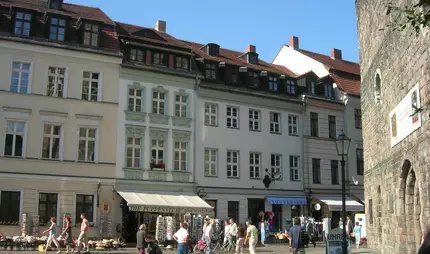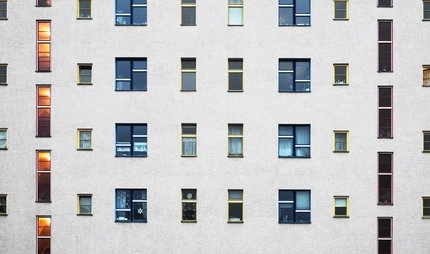
Märkisches Museum underground station
Art below ground
In 1896, Berlin began building elevated and underground railways, and by 1903 29 million passengers were using the new transport routes.
In the 19th century, Germany became one of the leading industrial nations, and the commercial use of electricity offered great economic potential.
But Berlin wanted more than just a functioning metro system, more than just tracks and stations. It demanded an artistic design for its transport network. This required an architect with a vision, and the city found him in the shape of Alfred Grenander.
Grenander was a Swede, but the focus of his work was in Berlin. He found a common architectural language for all the underground stations he designed here. When you walk through the station at Märkisches Museum, you’ll notice the coloured tiles. Grenander used them to cover the walls, and used different colours to indicate the different lines. At the same time, he gave each station an individual look – and Märkisches Museum station was no exception.
Built close to the water
At the turn of the century, Spittelmarkt was located right in the middle of Berlin’s city centre. In 1908, underground trains began running from there to Potsdamer Platz and to Charlottenburg, which was still a separate town. Berlin’s city councillors wanted an extension to the east – to Alexanderplatz and to Schönhauser Allee. The challenge was to build a transport line close to the river Spree without water getting into the underground tunnels. This was most difficult of all at the station then known as Inselbrücke, which later became Märkisches Museum.
Grenander found a solution by dropping the station more than six metres below street level. This depth opened up new possibilities: there was no need for steel girders to hold up the ceiling, and Grenander used the additional depth to install a basket arch vault that needed no girders. The only other structure like this in Berlin is at Platz der Luftbrücke U-Bahn station.
The building work took two years to complete. On 1 July 1913, the first underground train travelled from Spittelmarkt via Inselbrücke and Klosterstraße [internal link] to Alexanderplatz.
Into obscurity
The station didn’t get its present name until 1935, when it was renamed after the nearby Märkisches Museum, which showcases the history of the city of Berlin.
Grenander’s construction was very nearly completely lost. In the final days of the war, German and Soviet troops even fought in the underground railway tunnels and in May 1945, German units flooded Märkisches Museum station.
However, it was back in business astonishingly quickly, with the first post-war trains running on 31 June 1945. When the Allies divided up the city, the underground railway was not affected at first.
This changed when the Berlin Wall went up in 1961. For 28 years, Märkisches Museum station was on a little-used side route. Travel to West Berlin was prohibited. Not until 1993 was the entire route of the U2 line from Ruhleben to Pankow restored.
Today, the station at Märkisches Museum has been fully refurbished and restored to its former glory. Look out for Grenander’s stylistic elements: the green-framed billboards on the side walls, the specially-made tiles that replicate the originals, the oval station signs and the wooden benches.
Our tips for nearby Märkisches Museum U-Bahn station
Whatever you do, don’t miss a visit to the Märkisches Museum. There are also other sites of Berlin Modernism nearby. Two stops down the U2 is Alexanderplatz, where Karl-Marx-Allee begins. This monumental boulevard features icons of GDR architecture such as the Haus des Lehrers, Kino International or the “workers’ palace” apartment blocks on Stalinallee [internal link], now known as Karl-Marx-Allee, between Strausberger Platz and Frankfurter Tor. Another sight near Märkisches Museum station, on the other side of the Spree, is the historical heart of Berlin, the Nikolaiviertel, which was restored in the 1980s.
Practical information from visitBerlin
Märkisches Museum station is on the U2 underground line. To explore the city by public transport, we recommend the Berlin WelcomeCard.


